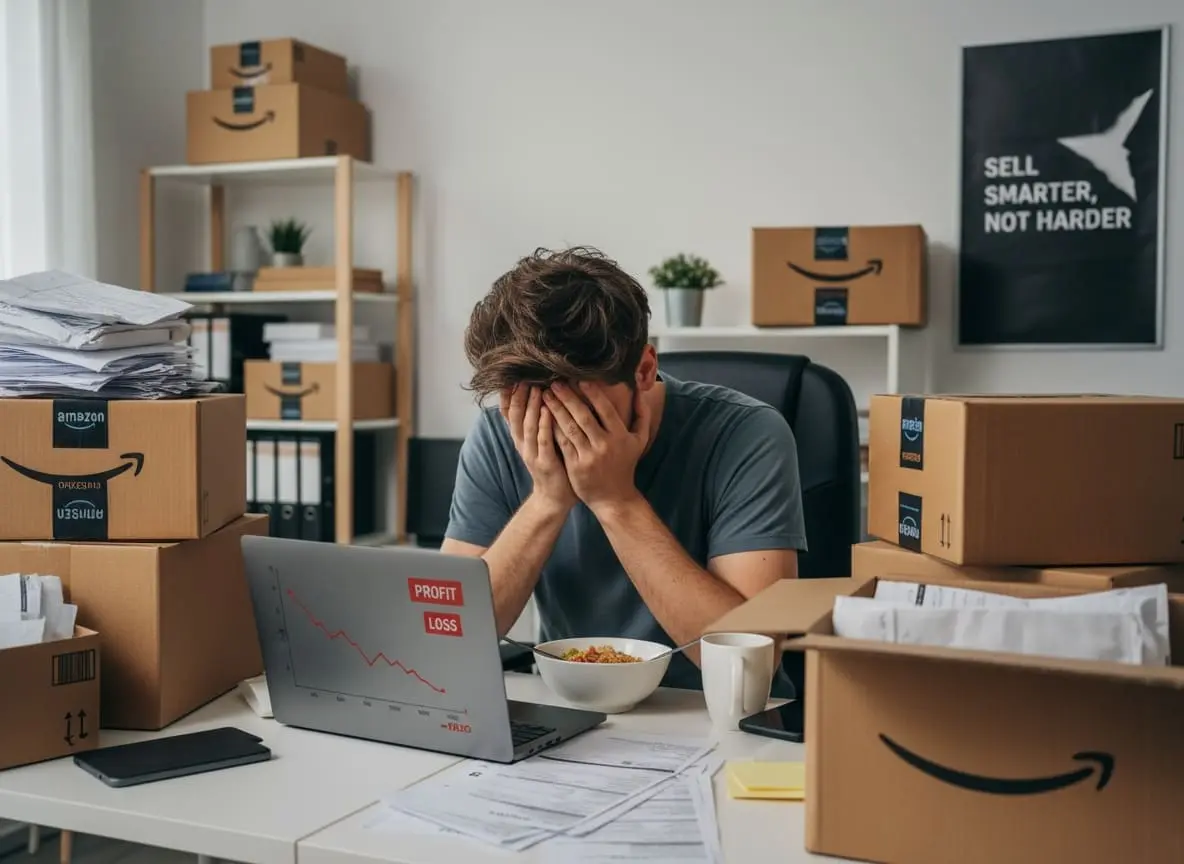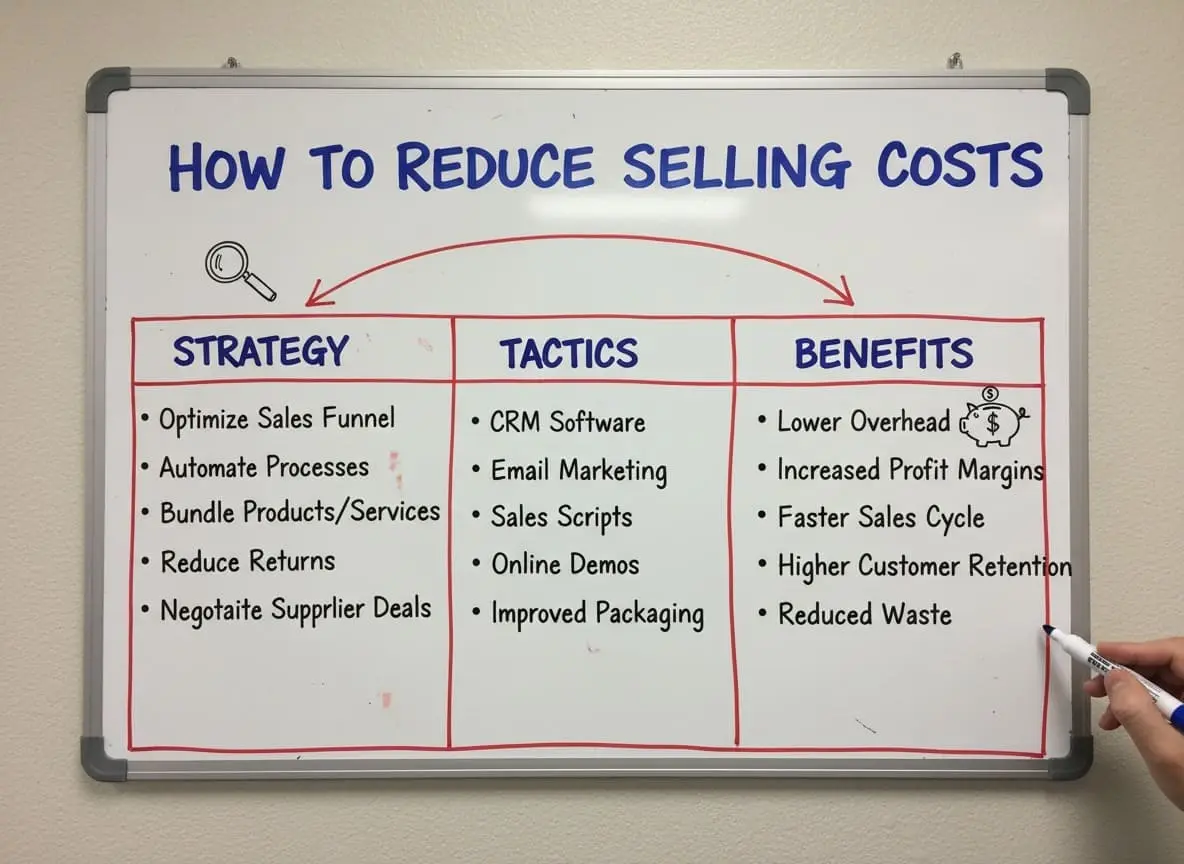TABLE OF CONTENTS
Why Do Most Amazon Sellers Lose Profit?
The Hidden Cost of Convenience
Pricing Pressure and Competition
How to Increase Margins on Amazon
- Choose Products That Can Absorb Costs
- Optimize Listings for Better Conversion
- Smarter Advertising and Promotion
How to Build a Sustainable Amazon Business
- Focus on Building a Brand, Rather than a Listing
- Understand the DTC vs Marketplace Model
- Use AI to Change Amazon Selling
If you’ve ever scrolled through YouTube or TikTok, you’ve probably seen someone say, “I made $100,000 in my first month on Amazon FBA.”
It sounds exciting. But talk to real sellers, and you’ll hear a very different story.
The margins are shrinking, advertising costs are increasing daily, and most importantly, Amazon, the platform that promises freedom, often takes the biggest cut of all.
So, with all of these going on, how can you build a truly profitable business? In this article, we’ll discuss that.
Why Do Most Amazon Sellers Lose Profit?

The Hidden Cost of Convenience
Amazon FBA (Fulfillment by Amazon) involves shipping your products to Amazon’s warehouse, while they handle storage, packing, and delivery.
It does sound convenient. However, in practice, every piece of that convenience comes at a cost.
You’ll pay referral fees (usually 8–15%), FBA storage fees, fulfillment fees, and possibly long-term storage penalties if your stock moves slowly.
Then there’s the Amazon PPC advertising cost, which has increased in recent years.
By the time all those deductions are applied, many sellers realize that Amazon takes away 30–50% of their revenue, sometimes more.
For instance, on a $100 sale, Amazon can take between $35 and $45 in combined fees, advertising, and logistics costs, depending on the product category.
Pricing Pressure and Competition
Amazon’s marketplace model prioritizes the lowest-priced offer. That means hundreds of similar listings are competing for the same keyword, driving prices down, and eating away at already-thin profit margins.
Big brands with bigger budgets can afford to undercut smaller sellers or win ad placements, making it even harder for newcomers to stand out.
And if you think you can rely solely on organic ranking, remember: those rankings are now heavily influenced by ad spend and reviews, both of which cost time and money to build.
How to Reduce Selling Costs

1. Streamline Your Operations
The best place to start is by reviewing your Amazon seller fees breakdown in Seller Central. Look for patterns, such as:
- Which products have the highest FBA storage cost?
- Are you overpaying for packaging or prep services?
Consider using third-party prep centers or negotiating better supplier rates. If you do this, every saved dollar in logistics or fulfillment goes straight to your bottom line.
Also, you should keep your packaging lean and protective. Lighter parcels reduce both storage and shipping fees.
2. Optimize FBA Fees
Amazon bases its fulfillment charges on size and weight tiers. This means that if you are redesigning packaging or bundling strategically, you can transition to a lower-tier option. Even a few grams can make a difference when shipping thousands of units.
Also, monitor inventory closely. Overstocking leads to long-term storage fees, while stockouts can harm ranking momentum. So, use forecasting tools to strike the right balance.
How to Increase Margins on Amazon

1. Choose Products That Can Absorb Costs
A major skill you need to have for FBA success is product selection. High-competition categories, such as phone accessories or generic home goods, have very thin margins. Instead of exploring these categories, look for niche products with loyal audiences or unique features that justify a higher price.
When you can differentiate on brand, design, or utility, you can price based on value, rather than competition.
2. Optimize Listings for Better Conversion
You need to optimize your listing if you want to double your conversion rate without increasing ad spend. Focus on:
- Clear, benefit-driven titles and bullet points
- High-quality lifestyle photos
- Keyword-rich but natural product descriptions
- Compelling A+ Content or Brand Story modules
If you’re unsure where to start, analyze top-performing competitors in your category and identify the emotions or pain points they are addressing that you aren’t.
3. Smarter Advertising and Promotion
You can’t avoid advertising on Amazon, but you can manage it better. Use Amazon PPC reports to identify which keywords convert, and pause the ones that don’t.
You should consider running smaller, targeted campaigns instead of broad auto campaigns, which can quickly drain your budget.
We recommend testing different creatives regularly.
How to Build a Sustainable Amazon Business

1. Focus on Building a Brand, Rather than a Listing
The easiest way to be a successful seller is to treat Amazon as a sales channel. Use it to acquire customers, then direct those customers toward your DTC website or email list.
You have to own your customer relationship; this is the only way to escape constant fee pressure. Your margins will grow when you sell directly, and you will have complete control over the customer experience from the first click to the repeat purchase.
2. Understand the DTC vs Marketplace Model
Here’s one way to think of Amazon and DTC:
It is your rented space in a crowded mall, with lots of foot traffic, but high rent and no customer data. Your own DTC site is like owning your boutique; you have fewer visitors, but every customer relationship is yours.
To succeed, you have to combine both. Use Amazon to gain visibility, then build retention through email, social media, and loyalty programs.
3. Use AI to Change Amazon Selling
Many parts of Amazon selling that once took hours (keyword research, pricing, ad bidding, even inventory forecasting) can now be done faster and more accurately with AI tools.
For example, AI-based pricing tools can adjust your prices in real-time based on competition, demand, and stock levels. Ad platforms can automatically pause poor-performing campaigns and redirect budget to high-converting ones. Even product listings can be optimized automatically, suggesting keywords and titles that are more likely to convert.
But AI isn’t just about speed. It’s about learning what customers want before they even start typing. Amazon’s own algorithm uses machine learning to predict what your potential shoppers are likely to buy next. This means that you can align their strategies with this data-driven system to stay visible longer.
Having said all this, relying entirely on automation can be risky. AI tools are helpful, but they don’t replace your understanding of the product, your market, or your customer. Use them to make smarter decisions, not to make all your decisions.
Strategies for Amazon FBA Sellers

So, how can you be successful on Amazon FBA in 2025? Well, we’ve curated a list for you:
1. Obsess over your customer: Every review, refund, or question is feedback
2. Invest in product quality: Better products mean fewer returns and stronger review velocity
3. Track every metric: Use ad spend, margins, and fees judiciously
4. Be financially prudent: Don’t overspend, so you can sustain your business
5. Think long-term: Use Amazon’s reach to fuel your own brand website and funnel
Conclusion
Selling on Amazon isn’t easy, but it’s still one of the most effective ways to grow an ecommerce business, if you approach it with the right mindset.
As we’ve previously established, Amazon rewards efficiency, not emotion. To survive, you must understand your customers and continually develop systems that improve over time.
You can’t control Amazon’s fees or competition, but you can control how you operate, how you price, how you advertise, and how you serve your buyers.
Our advice is that you treat Amazon FBA as your foundation. Use it to build visibility, gain experience, and fund the growth of your brand beyond the platform.
FAQs
- Why are Amazon seller profits shrinking?
Profit margins are getting smaller because competition has increased, ad costs have gone up, and Amazon’s fees keep rising.
- What is a good profit margin for Amazon sellers?
A healthy range is 15–25% after all fees and advertising costs. Anything below 10% can be risky, especially if your inventory or ad spend fluctuates.
- What is the success rate of Amazon FBA?
Roughly 10–20% of sellers maintain consistent profits after their first year of operation. Many new sellers struggle due to pricing pressure and a lack of differentiation.
- What are the disadvantages of FBA?
FBA simplifies storage and shipping but comes with high fees, limited control over customer interactions, and strict inventory rules. It’s convenient, but it’s not always the cheapest option.
- How much does Amazon take from a $100 sale?
On average, Amazon takes between $35–$45 when you include referral fees, storage, fulfillment, and advertising costs. The exact amount varies by category and product size.
- Which one is better, FBA or FBM?
It depends on your business. FBA is better if you want convenience and Prime eligibility. FBM (Fulfilled by Merchant) gives you more control and lower costs if you can handle shipping and customer service yourself.






.svg)

.avif)


.svg)